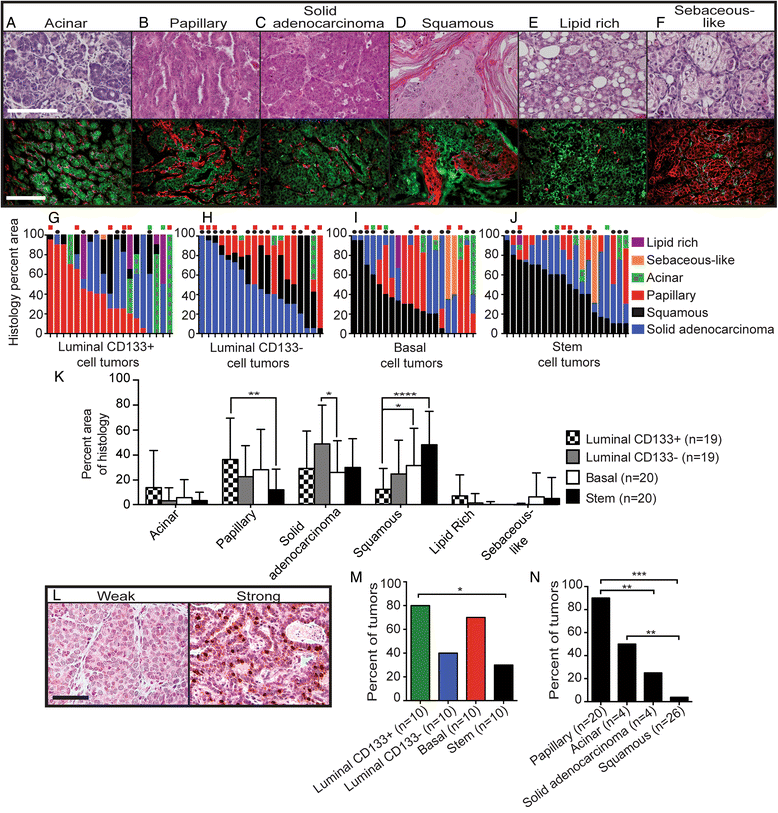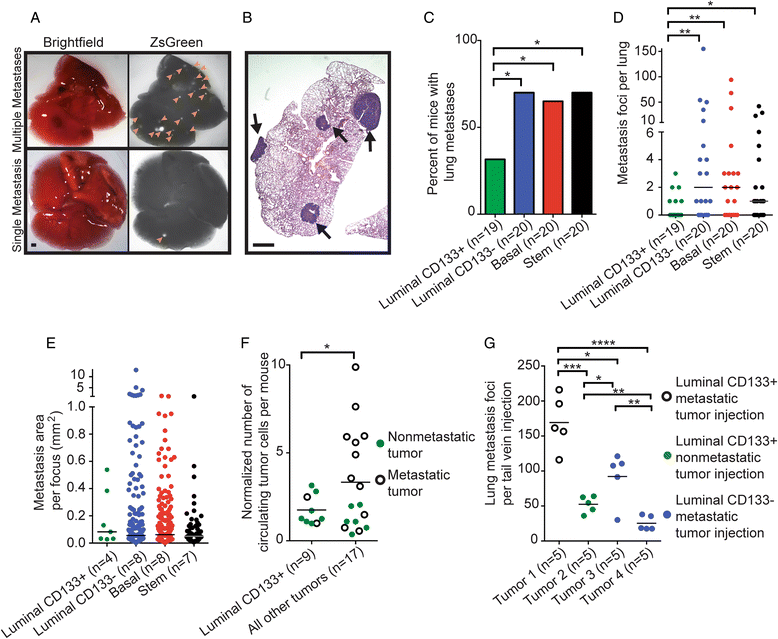Transformation of enriched mammary cell populations with polyomavirus middle T antigen influences tumor subtype and metastatic potential
- PMID: 26429062
- PMCID: PMC4589945
- DOI: 10.1186/s13058-015-0641-9
Transformation of enriched mammary cell populations with polyomavirus middle T antigen influences tumor subtype and metastatic potential
Abstract
Introduction: Breast cancer exhibits significant molecular, histological, and pathological diversity. Factors that impact this heterogeneity are poorly understood; however, transformation of distinct normal cell populations of the breast may generate different tumor phenotypes. Our previous study demonstrated that the polyomavirus middle T antigen (PyMT) oncogene can establish diverse tumor subtypes when broadly expressed within mouse mammary epithelial cells. In the present study, we assessed the molecular, histological, and metastatic outcomes in distinct mammary cell populations transformed with the PyMT gene.
Methods: Isolated mouse mammary epithelial cells were transduced with a lentivirus encoding PyMT during an overnight infection and then sorted into hormone receptor-positive luminal (CD133+), hormone receptor-negative luminal (CD133-), basal, and stem cell populations using the cell surface markers CD24, CD49f, and CD133. Each population was subsequently transplanted into syngeneic cleared mouse mammary fat pads to generate tumors. Tumors were classified by histology, estrogen receptor status, molecular subtype, and metastatic potential to investigate whether transformation of different enriched populations affects tumor phenotype.
Results: Although enriched mammary epithelial cell populations showed no difference in either the ability to form tumors or tumor latency, differences in prevalence of solid adenocarcinomas and squamous, papillary, and sebaceous-like tumors were observed. In particular, squamous metaplasia was observed more frequently in tumors derived from basal and stem cells than in luminal cells. Interestingly, both molecularly basal and luminal tumors developed from luminal CD133+, basal, and stem cell populations; however, luminal CD133- cells gave rise exclusively to molecularly basal tumors. Tumors arising from the luminal CD133-, basal, and stem cell populations were highly metastatic; however, luminal CD133+ cells generated tumors that were significantly less metastatic, possibly due to an inability of these tumor cells to escape the primary tumor site.
Conclusions: Expression of PyMT within different mammary cell populations influences tumor histology, molecular subtype, and metastatic potential. The data demonstrate that luminal CD133+ cells give rise to less metastatic tumors, luminal CD133- cells preferentially establish basal tumors, and the cell of origin for squamous metaplasia likely resides in the basal and stem cell populations.
Figures




Similar articles
-
Loss of amphiregulin reduces myoepithelial cell coverage of mammary ducts and alters breast tumor growth.Breast Cancer Res. 2018 Oct 26;20(1):131. doi: 10.1186/s13058-018-1057-0. Breast Cancer Res. 2018. PMID: 30367629 Free PMC article.
-
Neoplastic transformation of porcine mammary epithelial cells in vitro and tumor formation in vivo.BMC Cancer. 2015 Jul 31;15:562. doi: 10.1186/s12885-015-1572-7. BMC Cancer. 2015. PMID: 26228788 Free PMC article.
-
Metastasis is an early event in mouse mammary carcinomas and is associated with cells bearing stem cell markers.Breast Cancer Res. 2012 Jan 25;14(1):R18. doi: 10.1186/bcr3102. Breast Cancer Res. 2012. PMID: 22277639 Free PMC article.
-
Wnt signaling, stem cells, and the cellular origin of breast cancer.Stem Cell Rev. 2007 Jun;3(2):157-68. doi: 10.1007/s12015-007-0025-3. Stem Cell Rev. 2007. PMID: 17873348 Review.
-
Insights from transgenic mouse models of PyMT-induced breast cancer: recapitulating human breast cancer progression in vivo.Oncogene. 2021 Jan;40(3):475-491. doi: 10.1038/s41388-020-01560-0. Epub 2020 Nov 24. Oncogene. 2021. PMID: 33235291 Free PMC article. Review.
Cited by
-
Breast Cancer Macrophage Heterogeneity and Self-renewal are Determined by Spatial Localization.bioRxiv [Preprint]. 2023 Oct 27:2023.10.24.563749. doi: 10.1101/2023.10.24.563749. bioRxiv. 2023. PMID: 37961223 Free PMC article. Preprint.
-
A pipeline for identification and validation of tumor-specific antigens in a mouse model of metastatic breast cancer.Oncoimmunology. 2019 Nov 29;9(1):1685300. doi: 10.1080/2162402X.2019.1685300. eCollection 2020. Oncoimmunology. 2019. PMID: 32002300 Free PMC article.
-
The cell of origin dictates the temporal course of neurofibromatosis-1 (Nf1) low-grade glioma formation.Oncotarget. 2017 Jul 18;8(29):47206-47215. doi: 10.18632/oncotarget.17589. Oncotarget. 2017. PMID: 28525381 Free PMC article.
-
Mammary Precancerous Stem and Non-Stem Cells Evolve into Cancers of Distinct Subtypes.Cancer Res. 2019 Jan 1;79(1):61-71. doi: 10.1158/0008-5472.CAN-18-1087. Epub 2018 Nov 6. Cancer Res. 2019. PMID: 30401712 Free PMC article.
-
Rank ectopic expression in the presence of Neu and MMTV oncogenes alters mammary epithelial cell populations and their tumorigenic potential.J Mammary Gland Biol Neoplasia. 2023 Feb 18;28(1):2. doi: 10.1007/s10911-023-09530-4. J Mammary Gland Biol Neoplasia. 2023. PMID: 36808257 Free PMC article.
References
Publication types
MeSH terms
Substances
Grants and funding
LinkOut - more resources
Full Text Sources
Other Literature Sources
Medical
Research Materials

